Canon G5X Mark II Review
Canon G5X Mark II Review
Proves that the compact camera isn't dead yet

Verdict
It's a little pricey, but the G5X Mark II is one of the best compact cameras you can buy and a genuine step up from your smartphone camera. Its handling, electronic viewfinder, optical zoom, burst shooting and all-round image quality are impressive, even if it does lack the video-centric features of its G7X Mark III cousin. The lack of phase-detect autofocus does puts it behind the latest Sony RX100 models, and it's a shame there's no microphone input or fully articulating touchscreen. However, if you're looking for a mini version of your Canon DSLR or mirrorless camera to take out on day trips, then the G5X Mark II's versatility and image quality make it one of the best options around.
Pros
- Good image quality throughout the zoom range
- Genuinely pocketable
- Useful pop-up EVF
- Shoots uncropped 4K video
Cons
- No phase-detect autofocus
- No microphone input
- Lacks the G7X Mark III’s YouTube livestreaming
Key Specifications
- Review Price: £849
- Large 20.1-megapixel one-inch type CMOS sensor
- Pop-up 2.36-million dot OLED viewfinder
- 180-degree tilting touchscreen
- 24–120mm f/1.8-2.8 lens (5x optical zoom)
- Shoots 4K video at 25fps
- USB charging
What is the Canon G5X Mark II?
Looking for a pocket camera that has the performance and flexibility of a DSLR, without the bulk? Canon currently has three smartphone-beating options, collectively known as its Powershot G Series.
The family’s flagship is the G1X Mark III, a two-year-old model with an APS-C sensor (the same size as many larger cameras) and a £1,000 price tag.
But if you want a compact that’s genuinely pocketable, while offering comparable image quality and creative control to the G1X, then Canon’s two latest G series models could be for you.
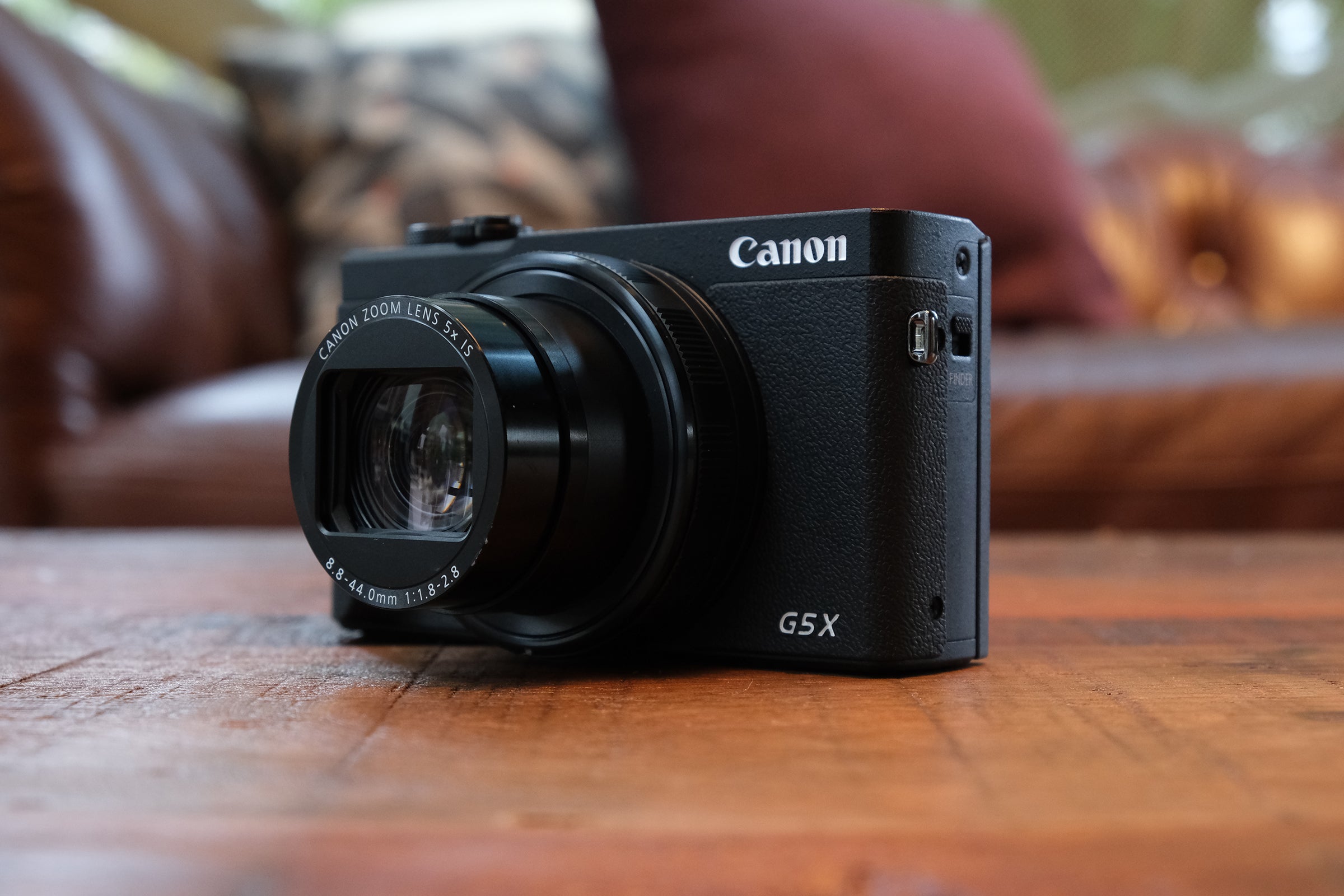
Both the G7X Mark III and G5X Mark II promise strong all-round performance, thanks to their new one-inch 20.1-megapixel sensor and ability to shoot uncropped 4K video at 25fps.
There are few fundamental differences that could sway your decision. While the G7X Mark III leans towards video and vlogging, thanks to its microphone input and YouTube livestreaming, the G5X Mark II is targeted more at stills photographers.
Its 24-120mm lens offers a longer 5x optical zoom and crucially it also has a pop-up optical viewfinder for composing photos in bright conditions. In this sense, the G5X Mark II is very much a direct rival to Sony’s RX100 series, our current favourite range of premium compact cameras.
So does the G5X Mark II have the photographic chops to take on Sony’s forthcoming RX100 VII, and is it really still better than shooting with a flagship smartphone like the Google Pixel 3? I spent a week with one to find out.
Design and viewfinder – The G5X Mark II’s viewfinder makes it a fine choice for stills, but it lacks a mic input
The G5X Mark II is a very different physical specimen to its predecessor from 2015. Overall, this is a good thing and a real boon for portability, though advanced shooters who like manual controls and permanent viewfinders will prefer the G1X Mark III.
The biggest change is the pop-up viewfinder, which replaces its predecessor’s somewhat bulky EVF hump. The G5X Mark II also no longer has a fully articulating touchscreen, which is a slight shame, instead going for a tilting display that can fold 180-degrees upwards and 45-degrees downwards.
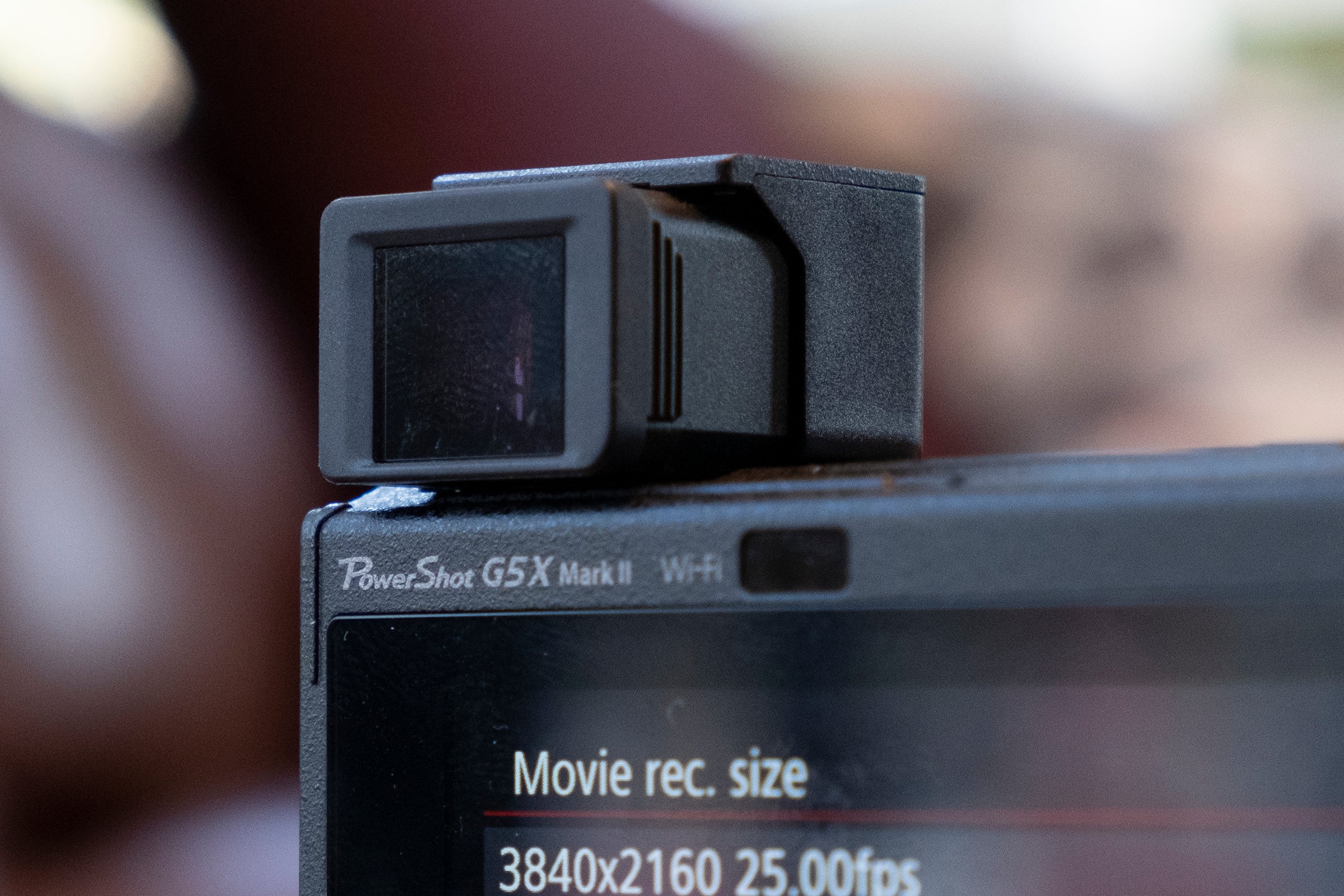
These two changes mean the G5X Mark II is 1.6cm shorter and 37g lighter than the original G5X. In practice, this means it’s able to squeeze into trouser pockets rather than just large jacket pockets, which is a crucial difference.
The G5X Mark II is a great ‘daily driver’ in other ways too. Handling is excellent for a compact, with a generous grip making it far more comfortable to hold and easier to steady than the slippery Sony RX100 series.
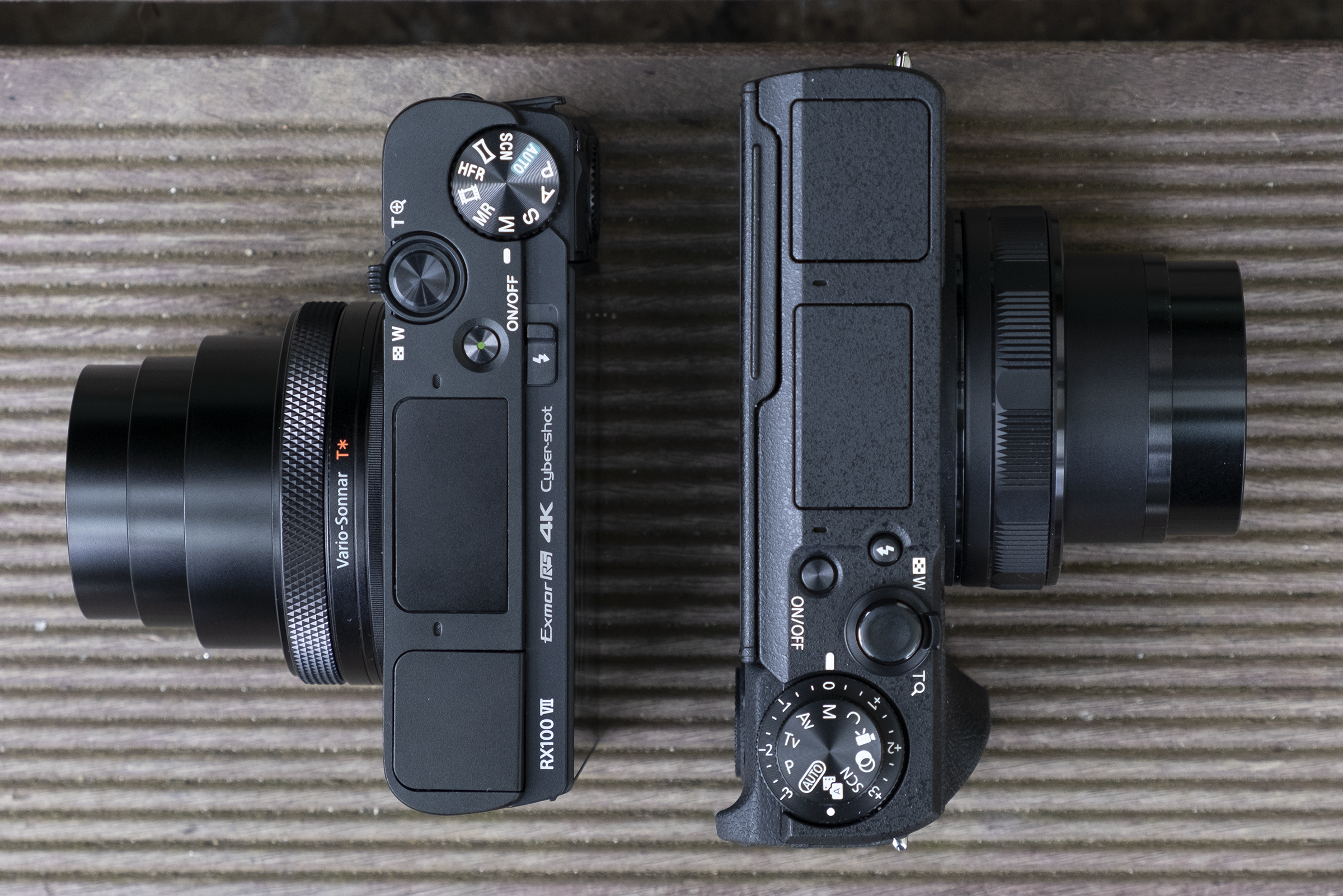
The new Sony RX100 Mark VII (left) is smaller but doesn’t handle quite as well as the Canon G5X Mark II (right)
The pop-up viewfinder works well too and is a big practical advantage over the G7X Mark III, and even some larger sensor compacts like Ricoh GR III. While quite small at 0.39-inches, its 2.39-million dot resolution is slightly higher than its predecessor’s and has a decent 120fps refresh rate, which makes it easy to follow fast-moving objects. ad
One slight downside of the EVF is that you need to press a switch to pop it up, then pull the eyepiece out towards you, in order to use it. This is something that Sony has rectified on its RX100 VI and VII models. Sounds like nit-picking? On a few occasions, I did find it made the difference between getting and missing a shot.

Other minor downers are that the lens control ring feels a little plasticky and imprecise for an £849 camera, and there’s also now no customisable front control dial, which made manual shooting much easier on the original G5X.
Still, if you mainly shoot in aperture or shutter priority modes, there’s enough control on the G5X Mark II to keep you happy, with an exposure compensation dial sitting underneath the program dial for those times when you want to quickly override the camera’s auto-exposure.
Even if it’s not quite as pro-leaning as its predecessor, the G5X Mark II’s combination of good handling, EVF and tilting screen make it a fun camera to use in most situations, and more comfortable and versatile than your smartphone.
Specs, features and performance – A great all-rounder for stills and video, but the G5X Mark II’s autofocus isn’t quite top tier
The three big new features on the G5X Mark II compared to its predecessor are a new sensor, processor and lens – which together ensure speedy performance and impressive image quality throughout its zoom range.
That one-inch 20.1-megapixel sensor has a stacked design, which means quicker readout speeds and, in turn, faster burst shooting performance. Thanks to a new Digic 8 processor, the G5X Mark II can shoot at an impressive 20fps (with your focus fixed on a subject) or 8fps for up to 320 JPEGs with autofocus.

Those figures are in perfect conditions with a UHS-1 Speed Class 3 memory card and, in my experience, I found the buffer filled up quicker than that, leaving the camera momentarily frozen for several seconds before I could start shooting again. But all you need to know is that the G5X Mark II is fast enough to capture pets, kids and most wildlife when using the mechanical shutter. There’s even a 30fps mode for shooting up to 70 RAW files.
Of course, speed is only one part of the photographic equation, and you’ll want those shots to be in focus too. On the whole, the G5X Mark II’s autofocus performs well, if not quite at the level of Sony’s latest RX100s. This is because it lacks Canon’s version of phase detect autofocus, called Dual Pixel AF, instead relying purely on the contrast detection method.
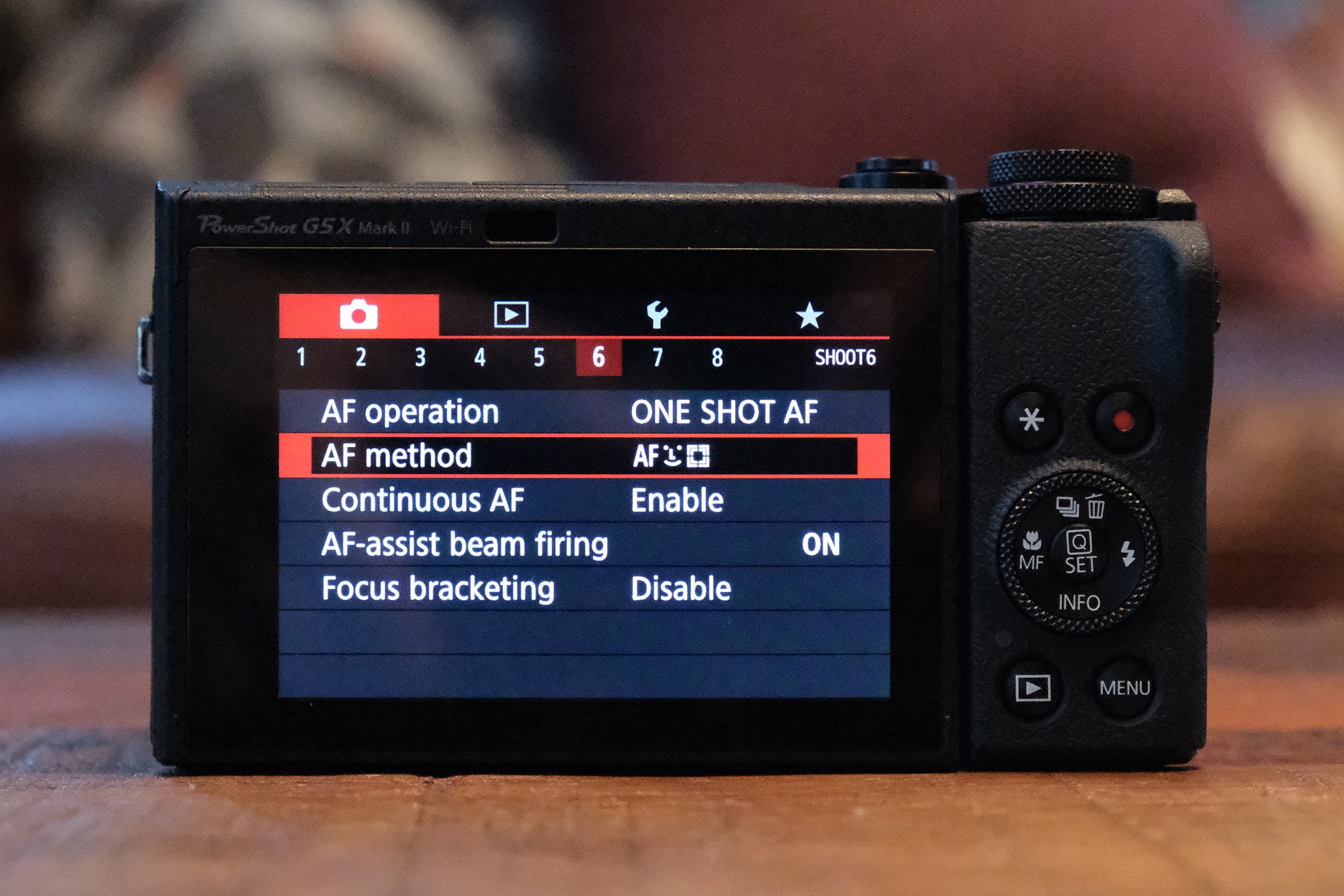
This still works well when shooting static subjects (which is contrast detection’s main strength), but it did mean a few more misses when I was shooting moving subjects, such as people and swimmers. Sony’s RX100 cameras, including the new RX100 VII, simply offer more autofocus options and features like Eye AF and Animal AF, along with great subject tracking, which is one of the main ways they justify their higher price. Right now, the only compact to have Canon’s Dual Pixel AF is the larger and older G1X Mark III.
Still, in many ways, the G5X Mark II’s direct rival is the older Sony RX100 Mark IV, which has a similar price (£799) and an EVF. And this is where the G5X Mark II’s new lens really stands out, offering a more useful 24-120mm zoom range (the equivalent of 5x optical zoom) compared to the RX100 Mark IV’s shorter 24-70mm lens.
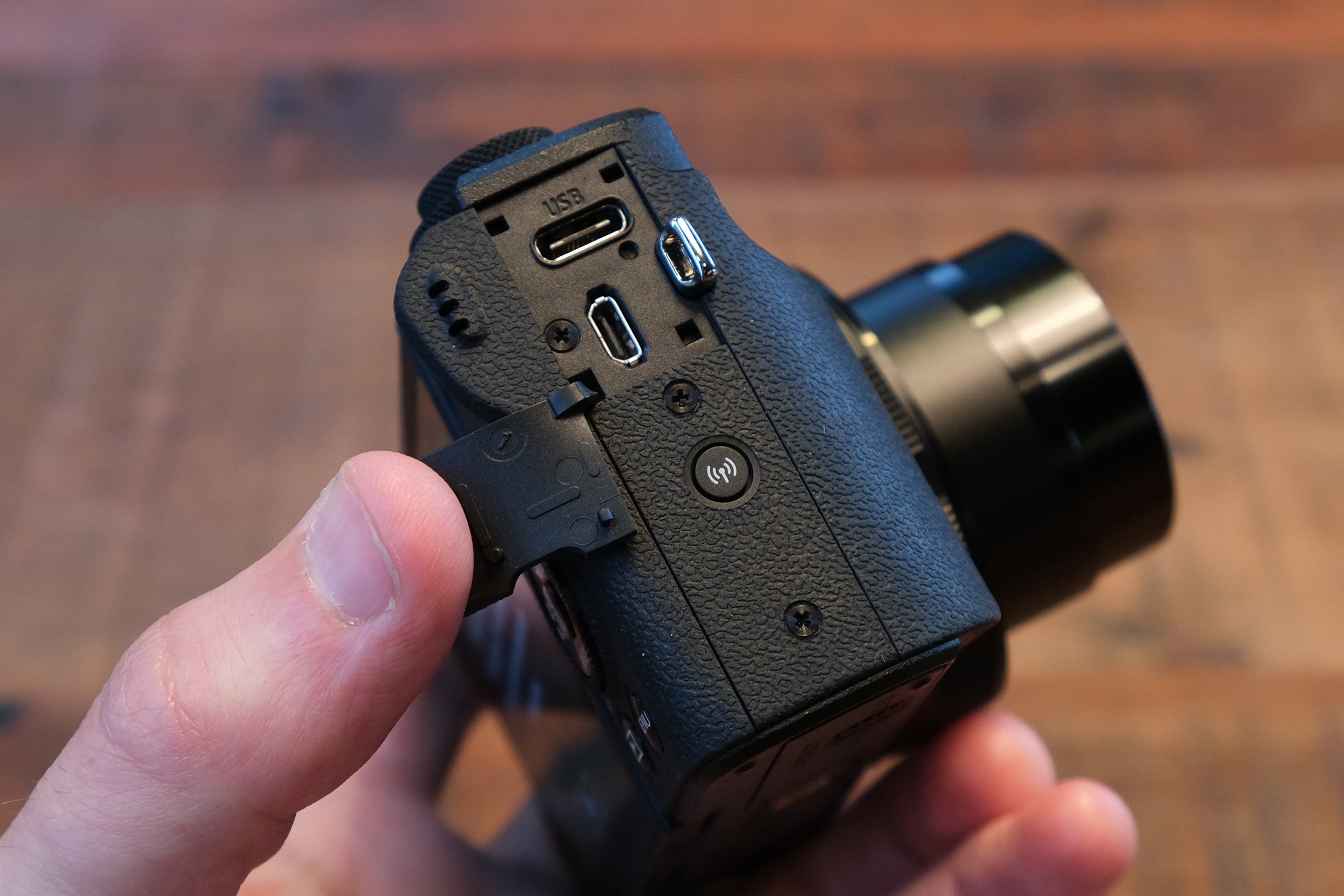
Canon’s lens backs this up with similarly bright apertures that range from f/1.8 at the wide end to a very decent f/2.8 at the long end, which means lots of light for it to work with and consequently less need to crank up the ISO to noise-inducing levels. See the image quality section below for examples from throughout the zoom range.
One final feature worth mentioning is that the G5X Mark II can now be charged directly from a USB-C power bank (assuming that pack has Power Delivery), which is handy because its battery life is average at best. Its CIPA rating lags behind the likes of the Sony RX100 V and Panasonic LX100 II, lasting for around 180 shots when using the EVF (or 230 shots without). So a battery pack, or a spare NB-13L battery, are pretty essential for all-day shooting.
Image quality – The G5X Mark II’s takes fine photos in most situations, but the G7X Mark III is better for video
The G5X Mark II’s new 20.1-megapixel sensor and bright lens are a great combo, producing shots with natural colour, decent dynamic range and smartphone-beating levels of detail.
It might lack the Animal Eye AF seen on Sony cameras like the RX100 VII, but the G5X Mark II’s autofocus and 20fps continuous shooting give it a strong chance of snagging shots of your fidgety cat or dog.

Shot at 1/400 at f/5.6, ISO 200, with a focal length of 28.52mm (77mm equivalent)
If you have good light, even the far end of its zoom range produces decent levels of detail, although the results naturally aren’t quite as pin-sharp in lower light or ISO 6400 and above.
The benefit of a one-inch sensor and bright lens is that you can use lower ISO settings in situations that might trouble compacts with smaller sensors, or smartphones that’ll be quickly reaching for their noise reduction algorithms.

Shot at 1/400 at f/5.6, ISO 125, with a 44mm focal length (119mm equivalent)
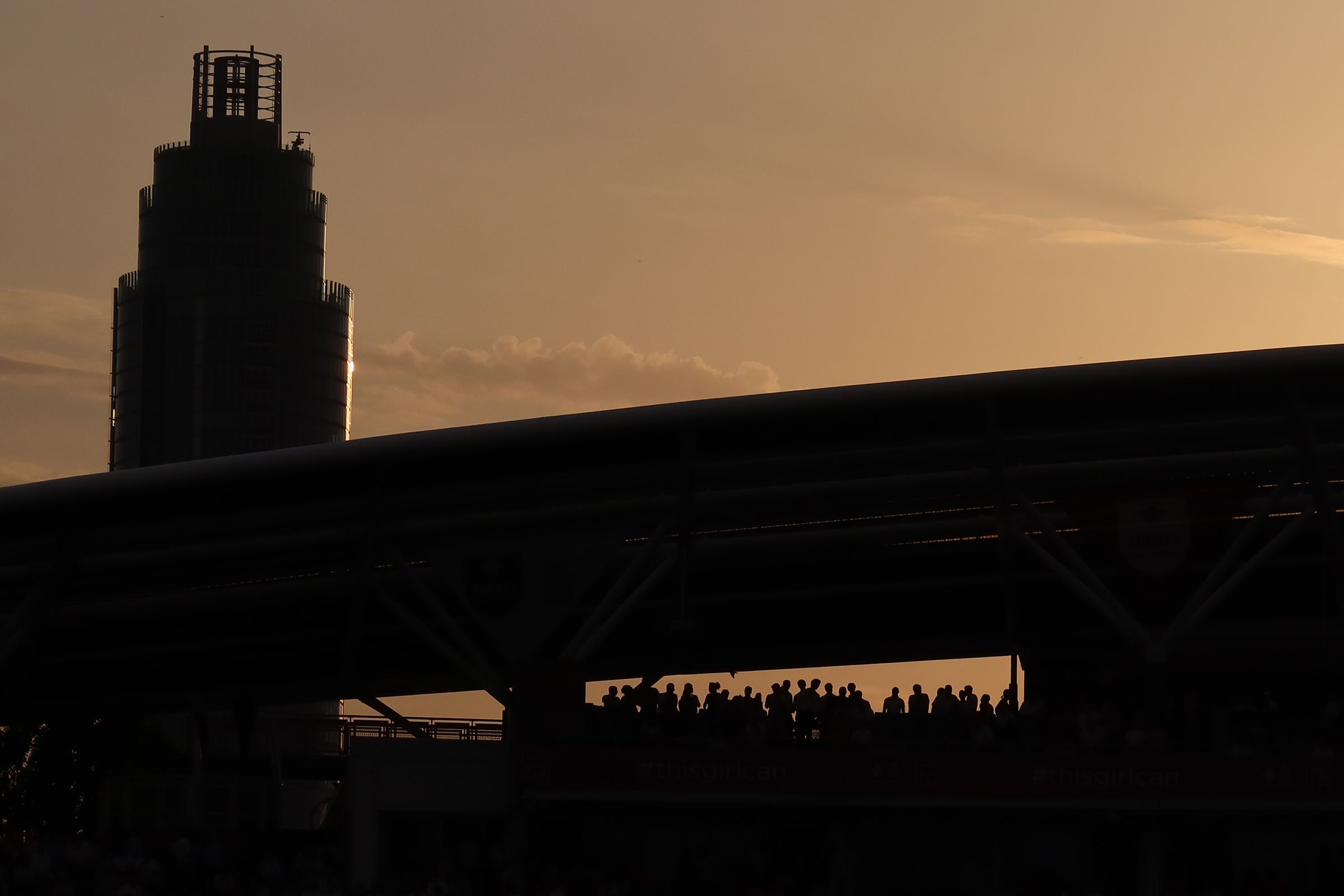
Shot at 1/500 at f/8, ISO 125, with a focal length of 44mm (119mm equivalent)
Aside from some lovely natural bokeh when using wide apertures, the G7X Mark II has the controls and tools to help you get creative with your shots too – whether that’s shooting Raw for post-processing your shots later, taking macro shots from 5cm, or simply using the exposure compensation dial to create some atmosphere or silhouettes.
What makes this model a step up from its predecessor is its burst shooting, which makes the G5X Mark II a good ally for capturing unpredictable subjects or action.
That said, it doesn’t have Canon’s Dual Pixel AF, and while it’s contrast-based system is a good performer in most situations, you’ll get your fair share of misses with really fast-moving action. Combine this with a slight lack of sharpness at the far end of the G5X Mark II’s zoom, and you get a camera that falls slightly short of Sony’s latest RX100s (and larger cameras like the Sony A6400) when it comes to shooting action and sport.
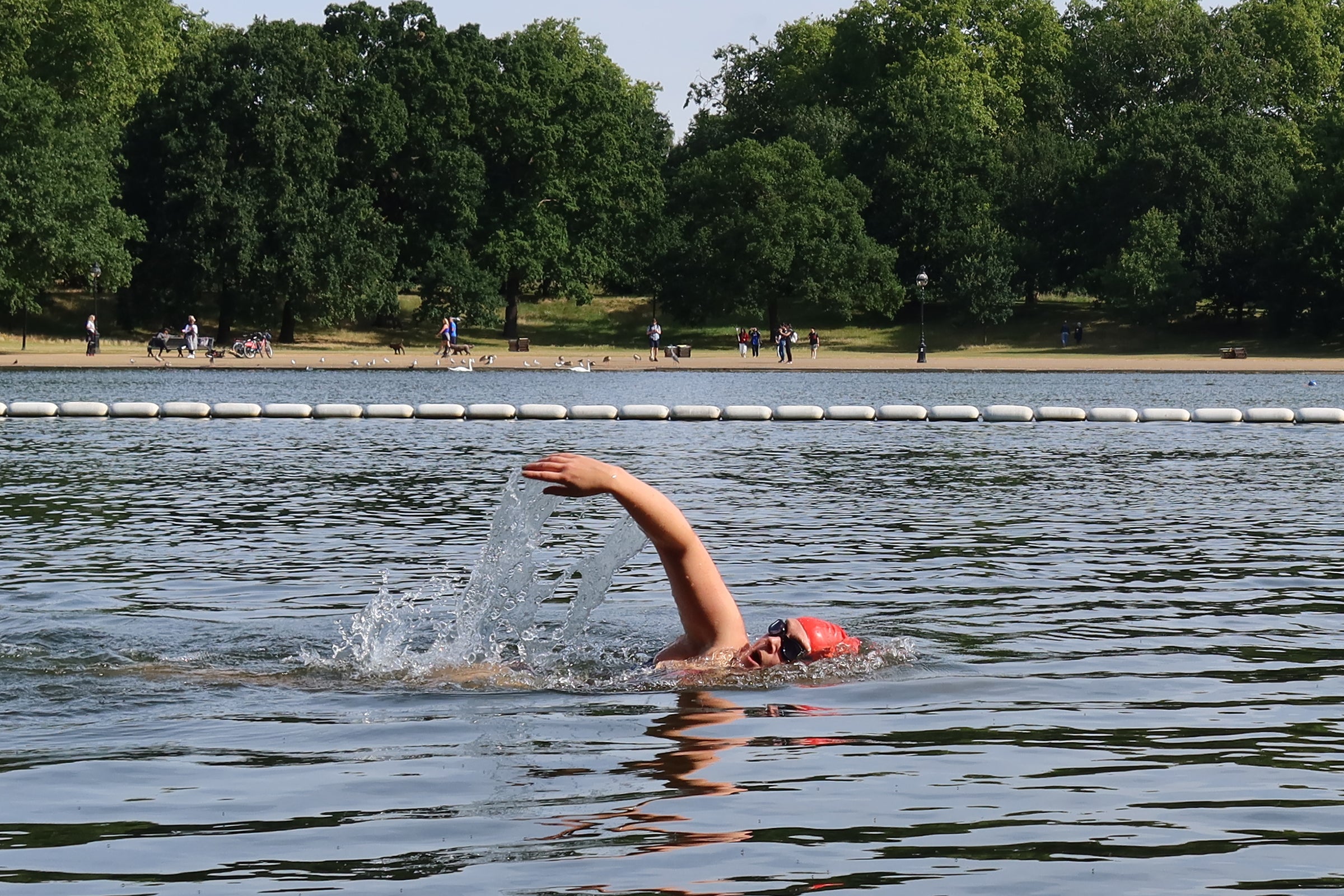
Shot at 1/800 at f/5.6, ISO 125 with a 14.89mm focal length (40mm equivalent)
Still, a lack of Animal Eye AF doesn’t mean you can’t rely on the G5X Mark II for animal close-ups, and its subject-tracking autofocus is generally pretty sticky.

Shot at 1/125 at f/4.5, ISO 640, with a focal length of 22.96mm (62mm equivalent)
The G5X Mark II’s extra zoom range of 24-120mm (compared to 24-100mm on the G7X Mark III) might not sound much, but it’s a very useful extra bit of reach, particularly for travellers.
It won’t get you right into the middle of the action at a cricket match, as the shot below shows, but the benefit of the G5X Mark II’s image quality and burst powers is that you can crop in and get a decent social media-friendly shot that would be beyond most smartphones.

Shot at 1/500 at f/3.2, ISO 125, with a 44mm focal length (115mm equivalent)
The G5X Mark II isn’t pin-sharp at the end of its zoom, particularly in tricky lighting conditions, but it’s still decent at the far end and lets you play with depth of field effects that are again difficult to recreate on a smartphone.
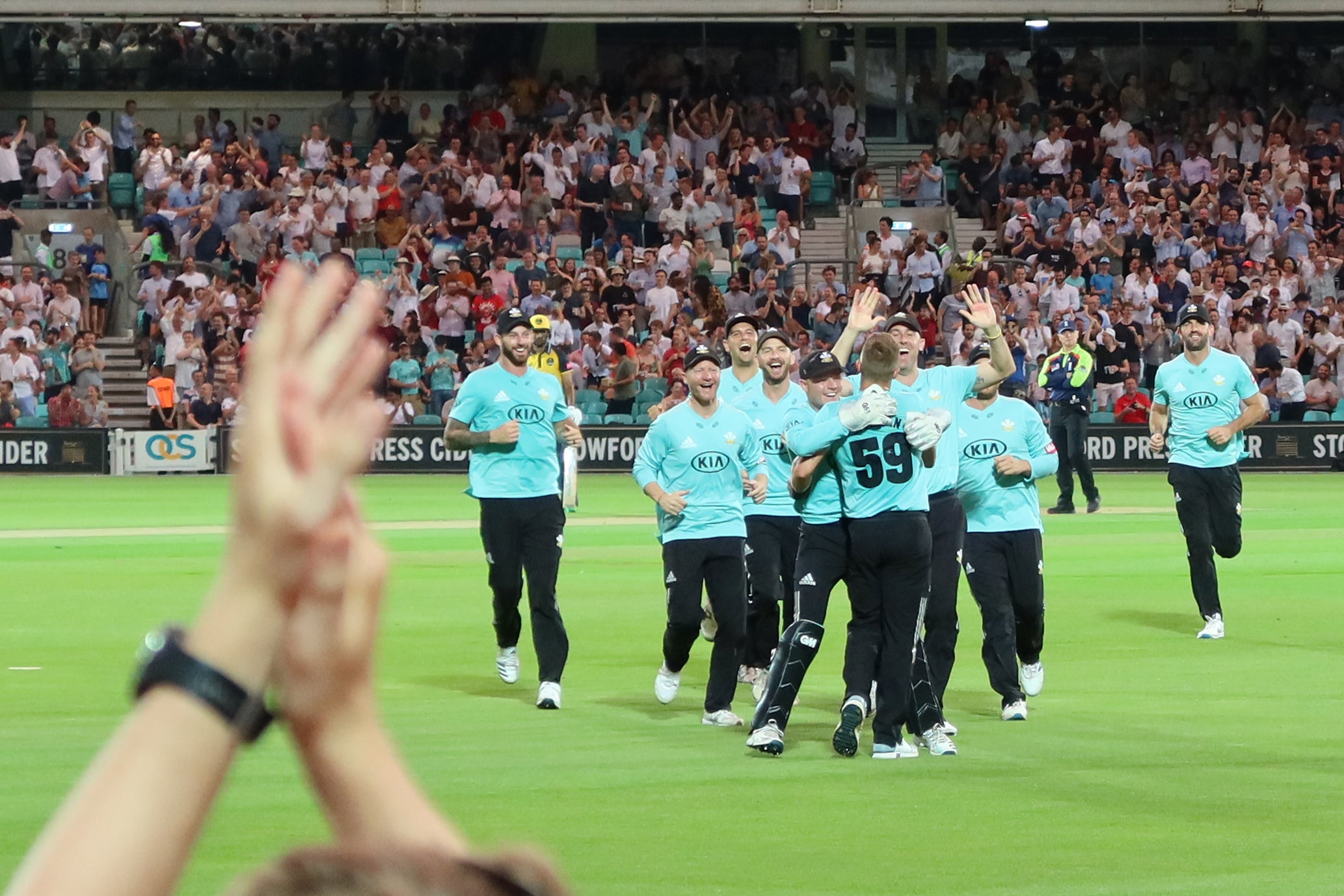
Cropped photo, shot at 1/500 at f/3.2, ISO 640, with a 37mm focal length (95mm equivalent)
Like its predecessor, the G5X Mark II’s combination of good metering and colour processing produces punchy shots that stay on the right side of being realistic without looking too over-processed. The large sensor and bright lens also create some pleasing background blur that is usually only possible on larger cameras or with (less reliable) simulated bokeh.

Shot at 1/400 at f2.5, ISO 160, with a 20.93mm focal length (57mm equivalent).
How does the G5X Mark II compare to a flagship smartphone like the Google Pixel 3? The three comparisons below will give you an idea – while there doesn’t appear to be a huge difference when viewed on a phone screen, the benefit of the G5X Mark II’s larger sensor, higher resolution and better optics becomes clear when you look a bit closer.
Canon G5X Mark II (left) vs Google Pixel 3 (right)
Smartphones like the Pixel 3 tend to apply heavy noise reduction at the expense of detail, so unless you’re absolutely sure that you’ll only ever want to view your snaps on the small screen, premium compacts like the G5X Mark II still make a lot of sense for travel snapping.
Canon G5X Mark II (100% crop, left) vs Google Pixel 3 (100% crop, right)
One area where smartphones do have the edge over one-inch compacts is special point-and-shoot modes like the Pixel 3’s Night Mode. To be fair on the G5X Mark II, its shot was taken in Aperture priority mode, and Canon does offer HDR and bracketing options. But the point isn’t that the G5X Mark II lacks the hardware to match the Pixel 3 in extreme situations, it’s that Google’s software lets you get these results in just a few seconds.
Canon G5X Mark II vs Google Pixel 3 (right)
When it comes to video, the G5X Mark II is a big step up on its predecessor, shooting 4K clips for up to ten minutes at a time (which is twice as long as Sony’s RX100 series) with the full width of the sensor.
It does lack the built-in microphone input and YouTube livestreaming of its G7X Mark III cousin, and there’s strangely no 24p video option, but video quality is very good overall, even if the autofocus is again not in the same class as the upcoming Sony RX100 VII.
In the set of sample videos below I’ve also recorded a short vlogging test to give you a taste of the internal microphone’s quality – while it’s certainly passable for travel clips, vloggers will likely be better off combining the G7X Mark III with an external microphone like the Rode VideoMic Go.
Should I buy the Canon G5X Mark II?
If you’re looking for a genuinely pocketable compact camera with smartphone-beating performance, then the G5X Mark II is certainly one of the best you can buy.
Is it worth £849? That is certainly a hefty investment for a compact camera, particularly when you consider that you can currently buy a Fujifilm X-T20 with a kit zoom for £50 less.
What you’re paying for, though, is the convenience of having an electronic viewfinder plus a sensor-lens combo that gives you near-DSLR image quality, in your pocket. And for many people – particularly those with a larger Canon DSLR or mirrorless camera – that combination will be well worth the cost. In fact, you may find the G5X Mark II is the camera you use the most, your smartphone included, given how convenient and capable it is.

The only real black marks are the lack of phase-detect autofocus (which affects its hit-rate for action and sports) and a microphone input (which you can find on the G7X Mark III).
This means those looking to save a bit of cash should also consider the Sony RX100 Mark IV (currently available for £579), which uses a similar sensor and also has a pop-up viewfinder.
But with the G5X Mark II offering a touchscreen, better zoom reach and faster burst shooting than the RX100 Mark IV, it’s certainly a very compelling new option between the older RX100s and Sony’s more capable, £1,200 RX100 Mark VII flagship.
Trusted Score
Features
| Camera type | Digital Compact |
| Megapixels (Megapixel) | 20.1 |
| Optical Zoom (Times) | 5 |
| Image Sensor | 1.0-type stacked CMOS sensor |
| Viewfinder | 2.36m-dot OLED EVF |
| Video (max res/format) | 4K/25fps |
Physical Specifications
| Dimensions Width (Millimeter) | 110.9 |
| Depth (Millimeter) | 60.9 |
| Length (Millimeter) | 46 |
| Weight (body only) (Kilogram) | 0.340 |


